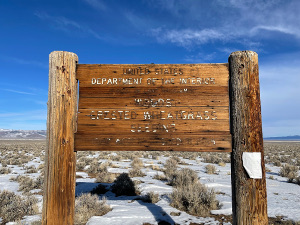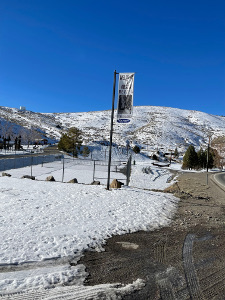 Crested Wheatgrass Roadside Sign
after a quick breakfast we loaded the truck and set off for a drive through more incredible scenery and a clutch of ghost towns in the Great Basin.
Crested Wheatgrass Roadside Sign
after a quick breakfast we loaded the truck and set off for a drive through more incredible scenery and a clutch of ghost towns in the Great Basin.
We were up and out early this morning, since we had no internet to waste our time! So  Crested Wheatgrass Roadside Sign
after a quick breakfast we loaded the truck and set off for a drive through more incredible scenery and a clutch of ghost towns in the Great Basin.
Crested Wheatgrass Roadside Sign
after a quick breakfast we loaded the truck and set off for a drive through more incredible scenery and a clutch of ghost towns in the Great Basin.
While it is still cold at night, and the altitude stresses our respiratory systems, we enjoy every moment of the drive. The roads are in excellent condition with little traffic to contend with, and the mountain ranges (we are told Nevada has 16 mountain ranges) are dramatic.
We drove past several settlements which are not identified on our official state map. A typical one is located in full view of the highway but would require a dirt road drive of several miles to approach. A dozen or more homes, sometimes purpose-built but more often double-wide mobile homes are nestled close to the foothills of a mountain. Often the reason for the settlement can be guessed: a herd of cattle in a nearby field, a mound of tailings from a mine. But others remain mysterious.
Occasionally we stop to read roadside signs. The one we read today said: "United States Department of the Interior. Bureau of Land Management. WOODS CRESTED WHEATGRASS  Eureka Court House 1879
SEEDING. 1300 Acres Seeded 1955." To understand what went on here 67 years ago we sought guidance from the internet, here. It turns out that approximately 10-26 million acres of desert rangeland were seeded with this Siberian wheatgrass to reduce soil erosion. But it is unclear if any of the wheatgrass has survived where this sign is located, as "stands often remain... productive for 30 years ..."
Eureka Court House 1879
SEEDING. 1300 Acres Seeded 1955." To understand what went on here 67 years ago we sought guidance from the internet, here. It turns out that approximately 10-26 million acres of desert rangeland were seeded with this Siberian wheatgrass to reduce soil erosion. But it is unclear if any of the wheatgrass has survived where this sign is located, as "stands often remain... productive for 30 years ..."
We were to find horses in groups of three to seven or more, standing in an open field. We decided they might be wild horses, some of which may be descendants of the horses of the Pony Express (our highway was a major Pony Express and stagecoach route. We couldn't get close enough to know more.
In Eureka, we photographed some of the 19th century buildings constructed during the boom days of the Comstock silver rush. Built of stone and cement, they have aged remarkably well considering the extremes of climate here. Each small town has its own story of boom and bust. The most recent bust was in 2008, but then there was Covid-19 from which these places are tentatively recovering.
 St. George's church banner, Austin
St. George's church banner, Austin
Today we saw a church sign in Austin which forced us to the internet where we learned about Nevada and Covid. The term "Social Distancing" came into public use when governments worked to reduce the spread of the virus. This must have caused quite a few giggles in Nevada, which in 1940 was the least populated state in the union (100,000 residents), and it was especially humorous on the widely publicized "Loneliest Highway," U.S. 50, which we drove this morning. So the tourist bureaus made "Social Distancing since 1862" a buzzword. And the old Episcopal St. George's church echoed the slogan in the never-ending drive to bring more people to church! We photographed the banner.
Round Mountain is one such experience. After successfully mining gold and silver, the town suffered a collapse when the mines closed. This caused most of the townspeople to leave for better opportunities to work, but now, partly as a result of better techniques for identifying and working with less-well known metals, mining is beginning to pick up again. The size of tailings (the ground dug up from open pit mines and piled neatly nearby) is astonishing.
We are staying this night in Tonopah, where we used to come for a day trip from Ridgecrest to play slot machines. This town has not seen much change, but it seems to be fairly stable in its shabbiness. Few businesses are open, but those that are are, as always, hopeful for the future. That is, we think, the nature of those who go prospecting.